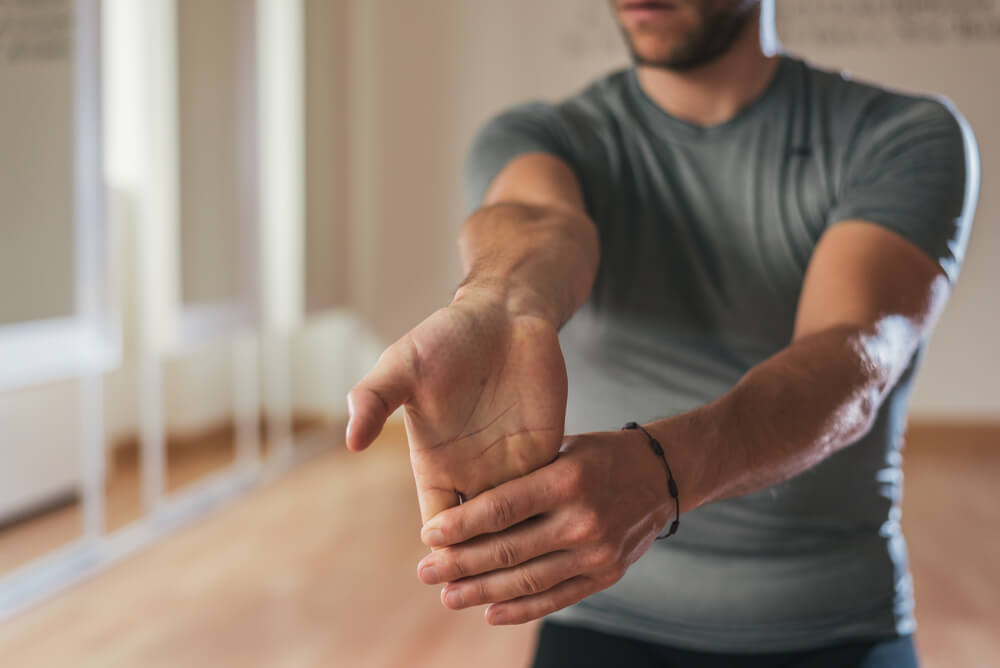
How to Protect Your Wrists When Lifting Weights
Start Slow
Never just grab a bar and start lifting a large amount of weight. Start slow, build your strength, and allow your wrist and other joints to adjust to your weightlifting routine. Warm up your wrists just as you do other joints and muscles in your body. Stretch and rotate to loosen up your wrists before you begin lifting. Warming up is a part of fitness, don’t forget the areas that you don’t typically think of as muscles. Even fingers can get strained and damaged by weight lifting.
Wrist Training
To avoid carpal tunnel or other wrist injuries, use grip exercises and wrist curls to increase flexibility and strengthen your hands and forearms. Wrist training techniques such as stress balls, and grip devices will help prepare you for weightlifting. The more prepared your hands and forearms are for weightlifting, the less strain you’ll put on your wrists.
Wrist Wraps
Reinforcing and supportive wrist wraps help to absorb some of the stress put on your wrists while weightlifting. There are a variety of wrist wraps available but even using weightlifting tape to wrap your wrists is better than nothing. Shop around and find the wrist wrap that meets your needs. Keep in mind that the base of the thumb is also an area that can be injured by repetitive stress motions and look for a wrist wrap that provides support there as well.
If you do experience a wrist injury, make sure you allow plenty of time for recovery before you begin lifting again. While you heal, take advantage of physical therapy exercises to make sure your wrist is in top condition before you put it under the strain of weightlifting.
Before beginning weight training, it is important that you know all the possible dangers and take steps to protect yourself from injury, strain, and pain. One small injury, such as a wrist strain can keep you off the weights for up to 6 months depending on the severity. Starting slow, wrist training and wrist wraps are all ways that can help keep you on the path to weight lifting success.
Subscribe Here!
Topics
- Accessible Fitness Machines (1)
- American Diabetes Association (1)
- American Heart Month (2)
- Awareness (3)
- Benefits of Kale (1)
- Best Fitness Websites (1)
- Breast Cancer (1)
- Breast Cancer Awareness (4)
- Buyer Beware (1)
- Cancer (1)
- Cancer Awareness (4)
- Carbohydrates (1)
- Cardio Aid (2)
- Cardio Equipment (7)
- Celebrity Fitness (1)
- Childhood Obesity (2)
- Christmas List (1)
- Commercial Fitness (12)
- Community (1)
- Corporate Wellness (5)
- Cortisol (1)
- Crossfit (2)
- Crosstrainer (1)
- Deals and Discounts (10)
- Diabetes Awareness (1)
- Diamondback Ellipticals (1)
- Diet (1)
- Diet and Nutrition (31)
- Diet Myths (1)
- Dietary Lifestyle Options (1)
- Eating Clean (1)
- EFX (1)
- Elliptical (14)
- Ellipticals (6)
- ElliptiGo (2)
- Energy (1)
- Exercise (6)
- Exercise Accessories (1)
- Exercise and Diabetes (1)
- Exercise at Work (1)
- Exercise Bike (6)
- Exercise Equipment (26)
- Exercise Equipment Demos (11)
- Exercise Machine (5)
- Exercise Prevents Cancer (1)
- Exercising at Night (1)
- Expresso Bike (2)
- Expresso Stationary Bike (2)
- Fat Loss (7)
- Fitness (23)
- Fitness Accessories (2)
- Fitness and Exercise (99)
- Fitness at Work (1)
- Fitness Blogs (6)
- Fitness Books (1)
- Fitness Education (75)
- Fitness for Special Needs (1)
- Fitness Gifts (1)
- Fitness Journey (5)
- Fitness Machine (11)
- Fitness Machines (4)
- Fitness Motivation (13)
- Fitness on the Go (1)
- Fitness Room (2)
- Fitness Stocking Stuffers (1)
- Fitness Technology (1)
- Fitness Tips (2)
- Fitness Tracker (1)
- Fitness Videos (1)
- Fitness Wearables (1)
- Flexibility (2)
- Food Myths (3)
- Fun and Educational Videos (9)
- Functional Training (3)
- Getting Back in Shape (1)
- GFX (1)
- Gift Ideas (1)
- Gluten Free (1)
- Goals (1)
- Gym Safety (1)
- Health (6)
- Health and Fitness (96)
- Health Myths (1)
- Healthy Eating (2)
- Healthy Food (6)
- Healthy Lifestyle (3)
- Healthy Recipes (4)
- Heart Disease (1)
- Heart Health (11)
- HIIT (7)
- HIIT at Home (7)
- Hip Hop (1)
- Holiday Eating (1)
- Holiday Fitness (1)
- Holiday Meals (1)
- Holiday Parties (1)
- Holidays (1)
- Home Fitness (77)
- Home Fitness Equipment (43)
- Home Fitness Machine (2)
- Home Gym (19)
- Home Gym Design (4)
- Hospitality Fitness (1)
- How to Get More Energy (1)
- Hydration (1)
- IFT (1)
- Injury Prevention (1)
- Insider (1)
- Inspiration (1)
- Inspire Ellipticals (1)
- Kale (1)
- Kids Fitness (2)
- Let's Move! (1)
- Low Cholesterol (1)
- Meal Planning (3)
- Men's Fitness (2)
- Metabolism Booster (1)
- Michelle Obama (1)
- Mobility (3)
- Motivation (1)
- Motivation to workout (4)
- Movember (1)
- New Product News (24)
- New Products (1)
- Nu-Step (1)
- Nustep (1)
- Nutrition (2)
- Nutrition Myths (2)
- Office Exercise (1)
- P3 News (7)
- P3 Retail Store News (12)
- Paleo (1)
- Partnership for a Healthier America (1)
- Personal Training (1)
- Postpartum Exercise Routine (1)
- Precor (17)
- Precor Ellipticals (6)
- Precor Treadmills (4)
- Push Pedal Pull (28)
- Recovery (1)
- Recumbent Bike (4)
- Recumbent Cross Trainers (1)
- Resistance Training (2)
- Resolutions (1)
- Rowing Machine (7)
- senior fitness (1)
- silver sneakers (1)
- Site Blog (33)
- Stay Active During Holidays (1)
- Strength Training (11)
- Stress (1)
- Stress Weight (1)
- Stretching (2)
- Strong is the New Skinny (1)
- Successful Resolutions (1)
- Trade in Elliptical (1)
- Trade in Fitness Equipment (1)
- Trade in Treadmill (1)
- Treadmill (13)
- Treadmills (7)
- True Treadmills (1)
- Used Elliptical (1)
- Used Equipment (3)
- Used Exercise Machines (1)
- Used Fitness Equipment (1)
- Used Treadmill (1)
- Valentine Workout (1)
- Valentine's Day (1)
- Vegan (1)
- Vibration Training (5)
- Warming Up (1)
- Weight loss (17)
- Weight Loss Booster (1)
- Weight Training (3)
- Women's Fitness (4)
- Working Out (5)
- Workout Inspiration (2)
- Workout Partner (2)
- Workouts (5)
